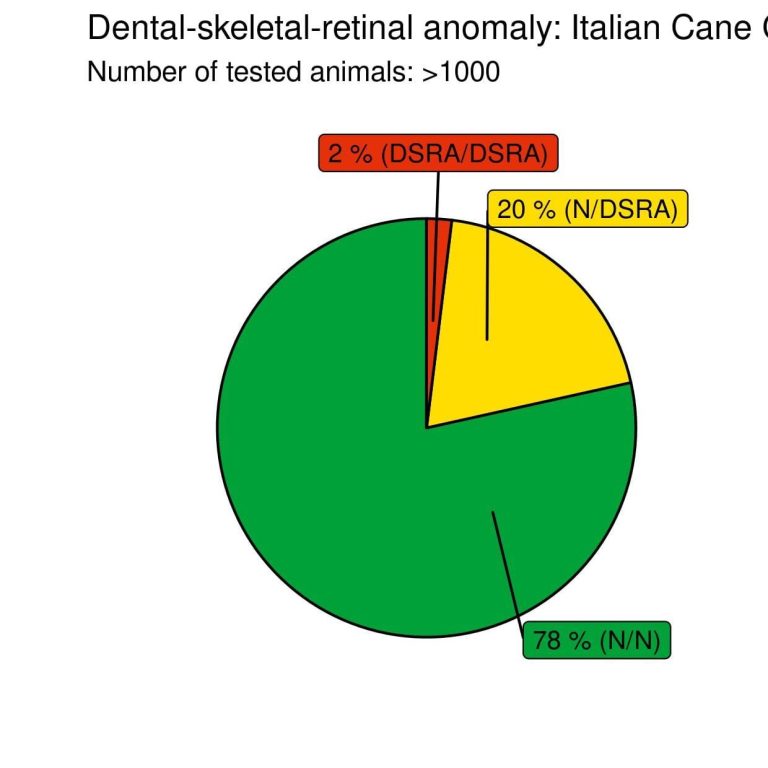Health Issues in the Cane Corso
Breed Specific Issues
DSRA – Dental, Skeletal, Retinal Atrophy.
DSRA is a hereditary condition that is characterised by brittle bones, abnormalities in the growth and development of the skeleton, weak, translucent or brittle teeth (alongside missing teeth), and progressive degenerative retinal atrophy resulting in loss of vision. There is no cure for this disease if a dog is genetically affected, and the prognosis can differ from dog to dog but generally DSRA will result in a shortened lifespan and pain for the dog which requires veterinary management.
In order for a dog to be a genetically affected by DSRA, both parents have to carry the mutation that causes it. In other words, both parents have to be a carrier. ICCGB recommends that when you buy a puppy, you look for both parents to have been tested DSRA CLEAR (N/N) which means that neither parent carries the variant, and that care should be taken if you intend to breed a DSRA CARRIER (N/n) and this should be clearly reported to the Club.
Breeders should never pair untested dogs due to the risk of DSRA.

Cherry Eye
In brachycephalic breeds, the tear duct of the third eyelid can sometimes pop out and cover some of the eye causing irritation. Cane Corso's are brachycephalic because their muzzle is 1/3 of the length of the head, so while extreme brachycephaly is outside of the breed standard and heavily discouraged, some health issues common to brachycephalic breeds can manifest within the Cane Corso such as Cherry Eye.
Cherry eye can occur because it is genetic, and the shape of the parent dogs eyes have an impact on the puppy, but cherry eye can also be caused environmentally. When pressure is put on the weaker ligaments around the eye and on the muzzle, this can damage the ligament itself and lead it to fail and the inner eyelid becoming exposed and swollen. This can happen if a dog is regularly wearing a face harness for walking and pulls against it, for example, as this puts pressure over the bridge of
the nose.
When cherry eye occurs, the Club recommends removal instead of having the eyelid “tacked”. This is because the tack often fails and the dog needs surgery anyway, so best to do it all at once. The breed community commonly have used Tudor House Vets and this practice comes highly recommended for resolving cherry eye.

Dysplasia – Hip & Elbow
Hip and elbow dysplasia is relatively common in large breed dogs. These conditions
are characterised by dysplastic changes in the joints leading to pain and difficulty in
movement, requiring veterinary management. Dysplasia can be diagnosed using x-
ray. It is important for puppy buyers to prioritise buying a puppy from a kennel who are hip and elbow scoring all of their dogs. Breeders do this to give their dogs and the puppies the best chance at health and longevity, as Cane Corso is an active breed. Look for parent scores of HD A (<10) or HB B (<25) and ED 0.
Epilepsy

Epilepsy is seen in some lines of the Cane Corso, but there is no available test for
idiopathic epilepsy. Epilepsy is characterised by a brain disorder that causes the dog to have seizures. Sometimes this can be caused by a head injury or other problem, but when there is no clear cause this is called idiopathic epilepsy and this can be genetic. However, it is difficult to track because there is no test and many owners and breeders don’t declare that their dog has this condition.
To track and gather data on epilepsy in the breed, any owners of a dog that has
epilepsy is encouraged to send their pedigree to the Club, or email us directly if your dog is already registered to tell us that your dog is affected. In order for an idiopathic epilepsy diagnosis report, your dog will have need to have had the full battery of tests recommended by a vet. There is an available test for juvenile epilepsy (JE & JME) with Laboklin, and juvenile epilepsy is covered in the full health test panel done by Embark.
A word of warning: as we can't test for epilepsy, we cannot guarantee which pedigrees may or may not contain it. Please ask your breeder what they have done to mitigate the risk of epilepsy in their specific breedings.

©Copyright. All rights reserved. ICCGB Est 2024
We need your consent to load the translations
We use a third-party service to translate the website content that may collect data about your activity. Please review the details in the privacy policy and accept the service to view the translations.
